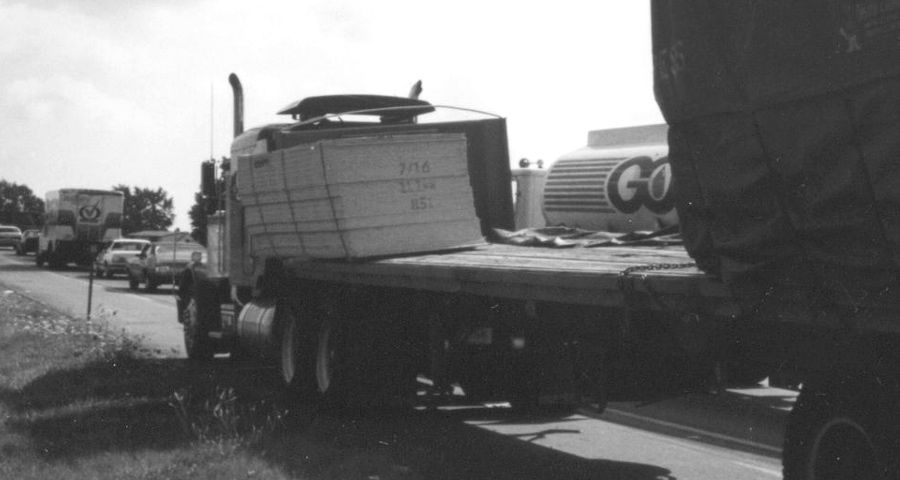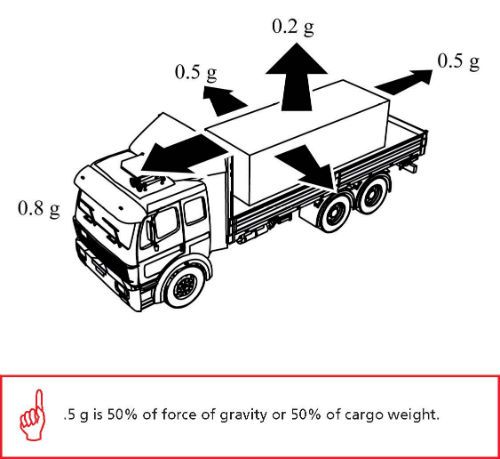Review Questions - Click On The Picture To Begin...

What is the minimum amount of rearward force that a cargo securement system must withstand?
- 50% of cargo weight
- 100% of cargo weight
- 20% of cargo weight
- 80% of cargo weight
Quote From The CDL Manual:
Each cargo securement system must be able to withstand a minimum amount of force in each direction.
- Forward Force = 80% of cargo weight when braking while driving straight ahead.
- Rearward Force = 50% of cargo weight when accelerating, shifting gears while climbing a hill, or braking in reverse.
- Sideways Force = 50% of cargo weight when turning, changing lanes, or braking while turning.
-
Upward Force = 20% of cargo weight when traveling over bumps in the road or cresting a hill.
- This requirement is satisfied when the cargo is "Fully Contained."
Next
If you were instructed to 'tarp' a load, what would you be using?
- A platform or tray on which cargo is placed so that it can be handled as an article.
- A waterproof sheet used to cover cargo.
- A strip of material that may be used to unitize articles and is tensioned and clamped or crimped back upon itself.
- A short piece of material, usually wood, nailed to the deck to reinforce blocking.
Quote From The CDL Manual:
Tarp:
A waterproof sheet used to cover cargo.
Prev
Next
When calculating directional forces, 'g' is expressed as:
- The maximum load that may be applied to a component of a cargo securement system during normal service, usually assigned by the manufacturer of the component.
- The acceleration due to gravity, 9.823 m/sec2 (32.2 ft/sec2). For cargo securement purposes it is expressed as a percentage of cargo weight, i.e. .5g is 50% of force of gravity or 50% of cargo weight.
- The summation of the working load limits or restraining capacity of all devices used to secure an article on a vehicle.
- The maximum load that may be applied to a component of a cargo securement system during normal service, usually assigned by the manufacturer of the component.
Quote From The CDL Manual:
g:
The acceleration due to gravity, 9.823 m/sec2 (32.2 ft/sec2). For cargo securement purposes it is expressed as a percentage of cargo weight, i.e. .5g is 50% of force of gravity or 50% of cargo weight.
Prev
Next
While driving, the freight must not:
- Obscure the driver's view ahead, left, or right.
- Prevent the exit of a person from the cab.
- Interfere with the free movement of the driver's arms or legs.
- All of these things should be avoided.
Quote From The CDL Manual:
The cargo or any other object must not:
- Obscure the driver's view ahead or to the right or left sides (except for drivers of self-steer dollies).
- Interfere with the free movement of the driver's arms or legs.
- Prevent the driver's free and ready access to accessories required for emergencies. OR
- Prevent the free and ready exit of any person from the commercial motor vehicle's cab or driver's compartment.
Prev
Next
Cargo securement for a load weighing 37,000 lbs must be able to withstand a minimum forward braking force of:
- 10,000 lbs
- 18,500 lbs
- 29,600 lbs
- 7,400 lbs
Quote From The CDL Manual:
How well must the securement system work? (Section 1.3)
Each cargo securement system must be able to withstand a minimum amount of force in each direction.
- Forward Force = 80% of cargo weight when braking while driving straight ahead.
- Rearward Force = 50% of cargo weight when accelerating, shifting gears while climbing a hill, or braking in reverse.
- Sideways Force = 50% of cargo weight when turning, changing lanes, or braking while turning.
-
Upward Force = 20% of cargo weight when traveling over bumps in the road or cresting a hill.
- This requirement is satisfied when the cargo is "Fully Contained."
TruckingTruth's Advice:
37,000 x 80% = 29,600 lbs.
Prev
Next
What is a headboard?
- A transverse load bearing structural component, particularly a part of a log bunk.
- A vertical barrier across the front of the deck of a vehicle to prevent forward movement of cargo.
- A vertical barrier across a vehicle to prevent forward movement of cargo.
- A vertical barrier placed directly behind the cab of a tractor to protect the cab in the event cargo should shift forward.
Quote From The CDL Manual:
Headboard:
A vertical barrier across the front of the deck of a vehicle to prevent forward movement of cargo.
Prev
Finish
Please select an option





 Related Cargo Securement Terms That Every Driver Should Know:
Related Cargo Securement Terms That Every Driver Should Know: 



 TT On Facebook
TT On Facebook